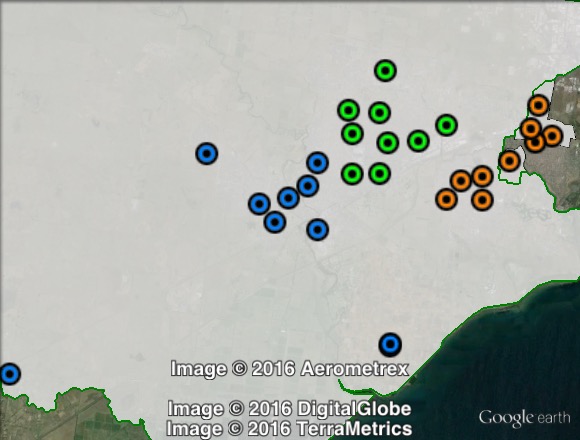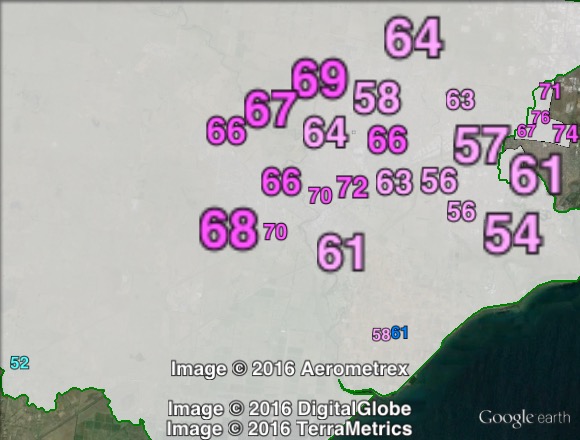ALP 12.2%
Incumbent MP
Joanne Ryan, since 2013.
Geography
Lalor covers areas on the western fringe of Melbourne and on the way to Geelong. The seat covers Werribee and surrounding areas. The seat covers all of Wyndham City and a small part of the City of Hobsons Bay near Altona.
History
Lalor was created in 1949 as part of the expansion of the House of Representatives. It has been won by the ALP at all but one election since then, and has usually been held by prominent Labor figures. The first four Labor MPs for the seat have held ministerial office, including two Deputy Prime Ministers and a Prime Minister.
The seat was first won in 1949 by the ALP’s Reg Pollard. Pollard had previously held the federal seat of Ballarat since 1937, and had served as a minister in the Chifley government between the 1946 and 1949 elections. He held Lalor until his defeat in 1966.
Pollard lost his seat to Liberal candidate Mervyn Lee in 1966. Lee attempted to move to the neighbouring seat of Bendigo in 1969, but failed to win the seat.
Lalor was won in 1969 by the ALP’s Jim Cairns. He had previously held the seat of Yarra since 1955, but the seat was abolished at the 1969 election. Cairns was a leading light of the Labor Left and was a leader of the movement against the Vietnam War.
Cairns was appointed to Gough Whitlam’s ministry after the 1972 election. He was elected Deputy Leader of the ALP, and thus Deputy Prime Minister, after the 1974 election, and later was appointed Treasurer. Cairns, however, was caught up in a sex scandal and the ‘Loans Affair’, and Whitlam sacked Cairns from the ministry in July 1975. Cairns retired from the Parliament in 1977.
Lalor was won in 1977 by state Labor MP and former radio host Barry Jones. Jones served as Minister for Science in the Hawke government from 1983 to 1990, when he failed to retain factional support for his ministerial position. He went on to serve as National President of the ALP from 1992 to 2000 and again in 2005-6. Jones retired in 1998.
Lalor was won in 1998 by Julia Gillard, who had most recently been chief of staff to Victorian Labor leader John Brumby. Gillard was promoted to the Labor frontbench, first as Shadow Minister for Immigration then Shadow Minister for Health.
In late 2006 Gillard joined with Kevin Rudd on a Labor leadership ticket, and she was elected Deputy Leader of the ALP, and Gillard took on the Workplace Relations portfolio. She became Deputy Prime Minister after the election of the Rudd government in 2007. In June 2010 she became Prime Minister after she was elected as Labor leader. She served as Prime Minister until June 2013, when she was replaced as Labor leader by her predecessor Kevin Rudd, and she announced her retirement from politics.
Lalor was won in 2013 by Joanne Ryan.
Candidates
- Marion Vale (Rise Up Australia)
- Joanne Ryan (Labor)
- Gayle Murphy (Liberal)
- Sue Jakobi (Australia First)
- Daniel Sova (Greens)
Assessment
Lalor is a safe Labor seat.
2013 result
| Candidate | Party | Votes | % | Swing |
| Joanne Ryan | Labor | 42,184 | 45.2 | -18.8 |
| Nihal Samara | Liberal | 27,321 | 29.3 | +6.1 |
| Beck Sheffield-Brotherton | Greens | 5,615 | 6.0 | -1.1 |
| Joe Zappia | Palmer United Party | 5,416 | 5.8 | +5.8 |
| Angel Harwood | Sex Party | 3,004 | 3.2 | +3.2 |
| Daryl Andrew Pollard | Family First | 2,653 | 2.8 | -0.1 |
| Nathan Mullins | Independent | 1,842 | 2.0 | +2.0 |
| Michael Freeman | Democratic Labour Party | 1,768 | 1.9 | +1.9 |
| Marion Vale | Rise Up Australia | 1,684 | 1.8 | +1.8 |
| Geoff Rogers | Australian Christians | 1,535 | 1.6 | +1.6 |
| Jonathan Page | Stable Population Party | 359 | 0.4 | +0.4 |
| Informal | 6,630 | 7.1 |
2013 two-party-preferred result
| Candidate | Party | Votes | % | Swing |
| Joanne Ryan | Labor | 58,041 | 62.2 | -10.0 |
| Nihal Samara | Liberal | 35,340 | 37.8 | +10.0 |

Booth breakdown
Booths have been divided into three areas: central, east and west. Those in “west” include Wyndham Vale and Werribee. Those in “central” include Hoppers Crossing and Tarneit. Those in “east” include Laverton and Seabrook.
The Labor two-party-preferred vote ranged from 60% in the east to 65% in the centre.
| Voter group | ALP 2PP % | Total votes | % of votes |
| Central | 65.1 | 22,672 | 24.3 |
| West | 64.3 | 18,846 | 20.2 |
| East | 60.3 | 17,364 | 18.6 |
| Other votes | 59.9 | 34,499 | 36.9 |


